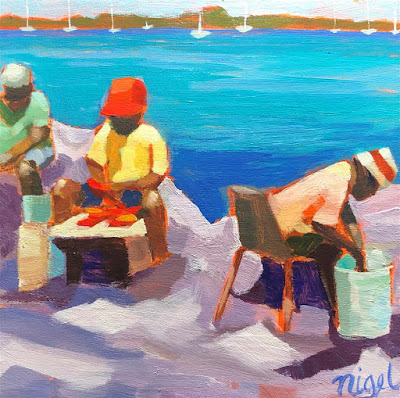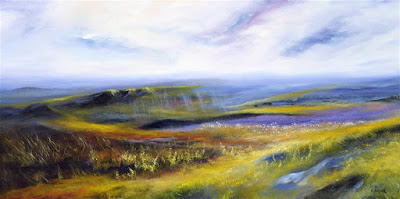Each week we will spotlight a different DPW artist who will give away one of their best paintings. To enter to win Matthew's painting "Ruby Red Grapefruit" go to Daily Paintworks and click on the link at the top of the page announcing their interview.
From Matthew's DPW Gallery Page:
Matthew Miller is an artist and architect who lives near Washington DC with his wife and corgi. His art comes from a wide variety of inspirations, ranging from capturing a moment or memory from his travels, to finding beauty in the little things. Regardless of the subject, Matthew loves using oil or acrylic paints to celebrate the light, mood, and atmosphere of a place, person, or object.
Matthew first picked up a paint brush when he was in middle school and has not put it down since. Although he has two degrees in architecture and practices architecture by day, he has been developing his art career with fervor, and, because of his dedication to the fine arts, he has consistently been participating in festivals, gallery exhibits, and competitions. Matthew would love for one of his pieces to be a part of your home.
Tell us a bit about how you first started painting.
When I was young, I had an affinity to doodling, and my mother recognized it as a means for my expression, so she bought me “How to Draw" books as well as some art materials. I studied them, I replicated the images, and I moved from "How to Draw" to "How to Paint" within a few years. By middle school, I was selling my friends drawings of their favorite sports cars. I took it upon myself to continue to challenge and critique my work so that, at any step in my painting career, I would be proud of the work I am producing, but always searching for the next step for improvement.
Did you have any stops and starts in your painting career?
Halfway through my undergraduate degree and through my Master’s degree, I took a break from painting. Architecture school is very demanding, and when you are working fourteen hours a day on school work, you have to rearrange your life priorities. I chose to prioritize my sleep! In the six years after graduation, I have been very productive, and I am excited to see my growth as an artist.
 |
Ruby Red Grapefruit
(click to view)
Enter to win by clicking on the link at the top of the DPW home page announcing Matthew's interview. |
What mediums and genres have you experimented with?
I had primarily worked in acrylic up until a year ago. I had just had my first solo show, and felt that it was the perfect time to try something new, with no deadlines in sight and the excitement of having accomplished a successful show. From that point, I switched to oil paint, and I am loving it! I feared that the slower drying times and the introduction to mediums and solvents would complicate the process; however, it has done nothing but open new doors to how I approach painting.
Which ones have "stuck" and which ones have fallen away?
Oil painting has been a joy, and for me, it is here to stay. I have occasionally used watercolor for in situ painting or quick studies. I applaud those who can master watercolor, but I could take it or leave it. It is certainly handy for travel, but I do not anticipate watercolor being my main medium.
Which ones are you looking forward to exploring?
Since I am relatively new to oil paint, I am looking forward to continuing my exploration of the medium. I am excited to try different surfaces, try both classic techniques and alla prima painting, and try varying degrees of realism and impressionism. The sky's the limit!
Who or what inspires you most?
One day, I hope to be able to paint like John Singer Sargent. His mastery and command of his brushstrokes seem effortless but at the same precise. His paintings, especially the Venice paintings, model light and color beautifully, and the varying degrees of focus and detail mimic our eyes' ability to see.
What does procrastination look like for you?
Painting is my second career. I work full time, and at the end of the day, when it is time to paint, I am exhausted. Sometimes the couch is much more inviting than the easel, but I know that once I mentally get over the procrastination hump and once I make the effort to open up a tube of paint and place a dab on the palette, that exhaustion melts away; I am reinvigorated and ready to tackle a painting session.
What techniques work to ensure that you make time for your art?
I keep a running checklist of daily tasks, and I ensure that I allot enough time to progress my paintings, especially if I have a show in the near future or commissions in the works. For me, this works wonders, because I know that I feel good when I am able to accomplish my daily goals, and on the flip side, I feel guilty if I get sidetracked.
How do you generally arrive at ideas for your paintings?
As an architect, I feel that experiencing the world around me is imperative to honing my craft. As an artist, I enjoy capturing a memory from my travels so that I can 1) learn from and commit to memory that moment in time through the sheer act of recreating it, and 2) share with others something I feel is worth sharing. Lately, because of COVID, the world I experience has gotten smaller, but it has not been without beauty. I have since found solace in painting some items I have found within the confines of my house.
How do you keep art "fresh?" What techniques have helped you avoid burnout and keep your work vibrant and engaging?
I never want to be pinned down to one subject matter. I will create a series of cityscapes, and then several months later, a series of still lifes, followed by a series of portraits. This constant changing of subjects has allowed me to breathe fresh air into my painting experience. Once painting starts to become a chore or repetitive, I know it's time to shake things up and paint something that excites me.
What do you feel you are learning about right now as an artist?
Currently, I am working on a series of portraits. I find that portraiture, unlike any other subject matter, has a high degree of difficulty. If your brushstroke is off, the expression of the subject changes. If several brushstrokes are off, your painting becomes a different person! I relish this challenge to, not only capture a person’s likeness, but also mood, personality, and expression. At the core of this challenge is developing my ability to see. If I am able to properly see and interpret my subject, then I stand a decent chance of properly representing my subject.
What makes you happiest about your art?
The process. Don’t get me wrong; the final product is rewarding, and even more so if someone chooses to hang one of my works in their home, but sitting down at my easel, with some good music and my palette loaded up -- nothing beats that. Every time I paint a painting, I learn something from it. Sometimes it's reinforcing or developing fundamentals, sometimes it is experimentation with a surface or medium mixture, and sometimes it's diving deep into the subject and living within the colors, forms and values. Occasionally, the process can be frustrating when things are not going the right way, but that only fuels me to step up to the challenge and approach the painting with trust that the process will lead to a great experience.
Thanks, Matthew!
© 2020 Sophie Marine


































